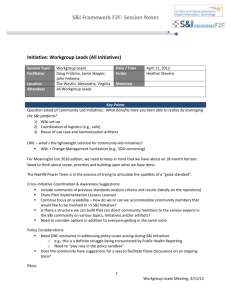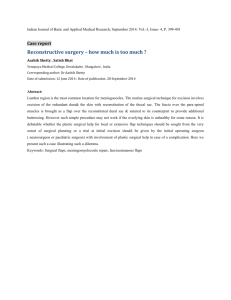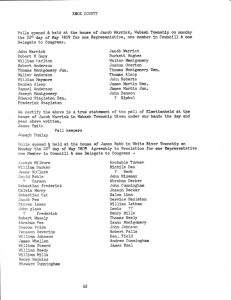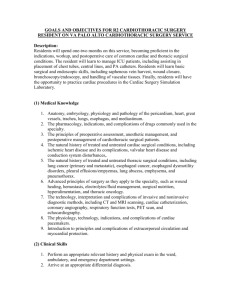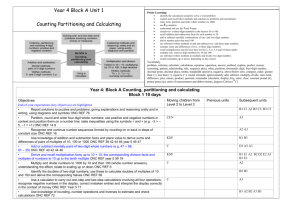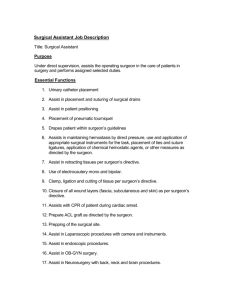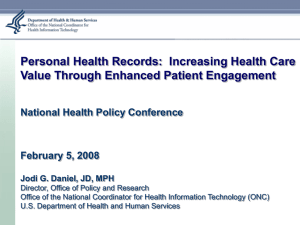Operations Research / Management Science in Health Care
advertisement
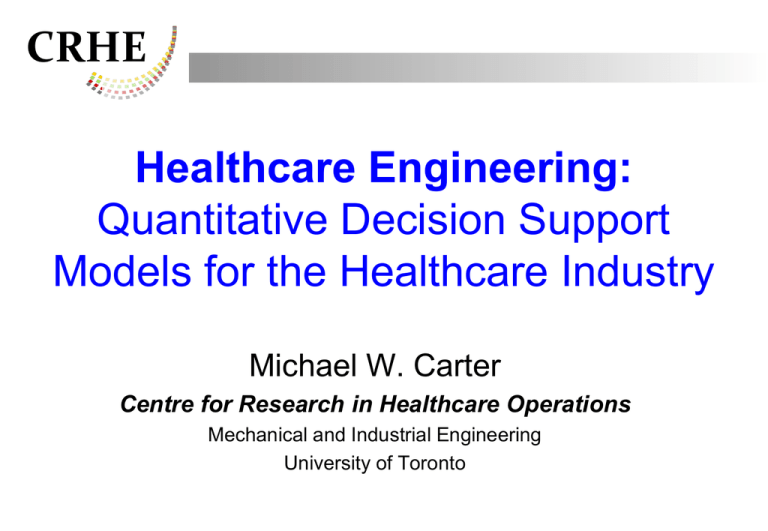
CRHE Healthcare Engineering: Quantitative Decision Support Models for the Healthcare Industry Michael W. Carter Centre for Research in Healthcare Operations Mechanical and Industrial Engineering University of Toronto CRHE Outline • Brief Overview of the Health Care Industry • Why do we need engineers? • Some application examples 2 CRHE o o o The Importance of Health Care Health care is North America’s largest single industry. Estimated total spending in Canada was $183 billion (CN) in 2009. ($2.5 trillion in the US) In Canada, in 2009, $5,452 per person was spent on health care compared to $8,047 in US 3 International Trends Health Spending as a % of GDP 20 US Canada France Germany % GDP 15 UK Netherland s Japan 10 Mexico OECD web site: www.oecd.org Oct 2007 '06 '04 '02 '00 98 96 94 92 90 88 86 84 82 80 5 Belgium Unfair Comparison: More $ doesn’t = better health? Life Expectancy 2003 Japan Sweden Switzerland Australia Canada New Zealand United Kingdom Netherlands France Germany United States 65.0 70.0 75.0 Women 80.0 Men 85.0 90.0 Infant Mortality per 1,000 live births 2003 United States New Zealand Canada United Kingdom Netherlands Australia Switzerland Germany France Sweden Japan 0.0 1.0 2.0 3.0 4.0 5.0 6.0 7.0 8.0 Health Care Delivery (% Public Payor in 2007) Public Payor Private Payor Public Provider UK (82), Japan (81) Private Provider Canada (70%), United States Germany (77) (45) France (79) Mix ** Most OECD states allow wealthy to opt out. of public system ** Mix Sweden (82) Holland (75) Commonwealth Fund Overall Ranking 2007 Country Rankings 1.0-2.66 2.67-4.33 4.34-6.0 AUST. CAN. GER N.Z. U.K. U.S. 3.5 5 2 3.5 1 6 4 6 2.5 2.5 1 5 Right Care 5 6 3 4 2 1 Safe Care 4 5 1 3 2 6 Coordinated Care 3 6 4 2 1 5 Patient-Centered Care 3 6 2 1 4 5 Access 3 5 1 2 4 6 Efficiency 4 5 3 2 1 6 Equity 2 5 4 3 1 6 Long, Healthy, and Productive Lives 1 3 2 4.5 4.5 6 $2,876* $3,165 $3,005* $2,083 $2,546 $6,102 OVERALL RANKING (2007) Quality Care Health Expenditures per Capita, 2004 * 2003 data Source: Calculated by Commonwealth Fund based on the Commonwealth Fund 2004 International Health Policy Survey, the Commonwealth Fund 2005 International Health Policy Survey of Sicker Adults, the 2006 Commonwealth Fund International Health Policy Survey of Primary Care Physicians, and the Commonwealth Fund Commission on a High Performance Health System National Scorecard. CRHE Systemic Hospital Issues: The Four Faces of Health Care* Containment Coalition Health care is a business, but... Multiple decision makers. Conflicting goals, incentives. Social “good”. No market, no manager. *Glouberman & Mintzberg, 2001 Trustees Community Managers Control Insider Coalition Status Coalition Doctors Nursing Cure Care Clinical Coalition 10 CRHE The Four Faces of Health Care* The same divisions apply to the overall social health system! Elected Officials Community Involvement Acute Hospital Acute Cure Health Authorities Insurance Public Control LTC, Primary Community Care *Glouberman & Mintzberg, 2001 11 CRHE Some success stories • Ontario Waitlist Forecast • System Dynamics: Cardiac Surgeons • Ministry of Health and Long Term Care and the Local Health Integration Networks (LHINs) • Cancer Care Ontario: Chemo Therapy Centres • Surgical Planning: Orthopaedic 12 CRHE Ontario Waitlist Initiative • Target to reduce wait times to benchmarks for five priority areas: Cardiac, Cataract, Cancer, Hip & Knee Replacement, MRI/CT • Problem: How many (cataracts) do we need to do to meet bench mark (90% wait less than 26 weeks) by March 2007? 13 CRHE Data Requirements for Prediction • • • • • • Current Patient Arrival Rate Projected Future Arrival Rate Current Waitlist Distribution of Patients on Waitlist (Priority) Surgical Volumes (Service Rates) Future Funded Surgical Volumes 14 CRHE Observed Waitlist Approximation Cataract Wait Times 450 Cutoff Point 400 350 300 250 200 150 Mean 90th Percentile Median 100 50 0 15 CRHE Ratio of 90th Percentile to the Mean 3 2.5 2 1.5 1 0.5 0 16 CRHE Cataract Surgery Arrivals Corrected Arrivals Total Surgeries 14000 13000 12000 11000 10000 9000 8000 7000 6000 5000 17 CRHE Recent Ontario Performance • Oct./Nov./Dec. 2009 (all priorities) – Hips – 23 weeks (Ont. target 90% in 26 weeks) – Knees – 26 weeks (target 26) – Cataracts – 16 weeks (target 26) – Breast cancer – 5 weeks (target 12) – Colorectal cancer – 6 weeks (target 12) – Cardiac Bypass – 8 weeks (target 26) – MRI – 16.6 weeks (target 4) – CT – 7 weeks (target 4) www.health.gov.on.ca 18 CRHE Health Human Resources Modelling CRHE Modeling the Future of Canadian Cardiac Surgery Workforce Using System Dynamics Michael Carter1,Chris Feindel2,Timothy Latham2 & Sonia Vanderby1 1Centre for Research in Healthcare Engineering, University of Toronto 2Canadian Society of Cardiac Surgeons CRHE I In Canada only 5 out of 11 slots were filled in 2009 match CRHE But . . . Retiring Surgeon Population Demand patterns … Cardiac Surgery Rates Current Cardiac Surgeons by Age 45 to 49 16% 50 to 54 18% 40 to 44 23% > 50 55 to 59 12% 60 to 68 13% 35 to 39 14% Per-Capita Surgical Rate 0.45% 0.40% 0.35% 0.30% 0.25% 0.20% 0.15% 0.10% 0.05% Male 0.00% <15 30 to 34 4% 20-39 40-64 65-74 Female > 75+ Age Cohort CABG Non-CABG CRHE Population is aging … Canadian Population Projections by Age 12000 Population ( 000s) 10000 40 to 60 20 to 40 8000 Under 20 6000 60 to 80 4000 2000 0 2006 Over 80 2011 Under 20 2016 20 to 40 2021 40 to 60 60 to 80 2026 Over 80 2031 CRHE Study Motivation • Will there be a future shortage of surgeons? • Specialty selection decisions being made based on current situation – Current oversupply; unemployed grads – Education Process > 10 years CRHE Causal Loop (Influence) Diagram IMG Module International Medical Graduates Student Population Module Surgeon Population Module Practicing Surgeon Population Total Surgical Capacity Student Population Demand Module General Population Surgical Demand per capita Clinical Productivity Module Total Surgical Demand Demand-Supply Gap Average Clinical Productivity per surgeon CRHE Scenario Testing R-1 Entry responds to Unemployment Persons 15 10 5 0 2008 grads 2012 2016 unemployed grads 2020 2024 Net Surgeon Shortage 2028 R-1 Entry CRHE Other System Dynamics Projects • Alberta Health & Wellness – Model for demand for GPs for next ten years • Ontario MOHLTC – Model impact of “Aging at Home” strategy – Model of mental health strategies May 20, 2009 Operations Research & Patient Flow 27 CRHE national/regional economic strength eligibility requirements of tuition supports ODSP eligibility requirements OW eligibility requirements acessibility of financial supports ability to afford education & training eligibility for and amount of ODSP received productivity availability of jobs eligibility for and wage/salary amount of OW received work related medical benefits costs of care? + willingness to ability to pay for find job care awareness of financial support options education/ training level life skills & abilities ability to attend school & work + Income level ability to keep job ability to find a job + Level of care required likelihood of "sticking with" care delays + obtaining care+- likelihood of seeking level of sense of disability + school/community community/school financial supports + attachment involvement + nutrition & healthy homelessness opportunities for lifestyle school/community transportation rurality ? + + involvement barriers/physical situational stress divorce/b isolation + ability to obtain & afford reak-ups ability to afford & insurance (auto & home) availability of + stigma + maintain appropriate ? in MH&A settlement support change +demands of chronic disease language + housing - physical health - barriers + ++ home life + + + manageability of + + culture sense of MHA isolation/community age # of single parent coordination & families ? trauma effectiveness of major life + discrimination community planning + + transitions + genetics/family involvement in use of alcohol, tobacco, abuse - of MH&A2 -history gambling sexual + other substances quality of orientation + + suicide rate availability of +relationships availability of healthy gambling substances environment availability of parenting + classes/daycare/ECE out-of-pocket medical costs duration, continuity & comprehensiven ess of care + + + - accessibility of care/support + + + ED arrivals + personal + - likelihood of + seeking care reliance on informal/family care providers + + education & skills of providers Likelihood & influence of family support/intervention + contacts with justice system + +demand for legal demand for law assistance enforcement -+ + ? appropriateness of referrals + care eligibility Demand for support/care + ? use of evidence based care availability of MHA treatment in EDs prestige/r eputation + awareness of care & support options + + use of common assessment & intake procedures requirements adverse selection ? + ED staff ? turnover provider ? incentives + provider attitude + + funding regime & duration collaboration & coordination of care ? ? + effectiveness of care + + + likelihood of being eligible for care + symptom + + identification + + involvement in care workload / provider + availability of care/support public education of MHA + + outcome monitoring & reporting + + research & development of care standards CRHE Local Health Integration Networks (LHINs) Planning Tools for “Aging at Home” GIS models of Supply & Demand Ali Esensoy, Agnita Pal & Mike Carter Demand Estimation Estimated Adult Day Program Demand in TC LHIN Adult Day Program Supply in TC LHIN Cluster Analysis of ADP Gap in TC LHIN CRHE Cancer Care Ontario How many medical oncologists do we need in Ontario? Graham Woodward, Adriane Castellino, Matt Nelson & Mike Carter CRHE HHR Model How are teams of providers configured in chemo clinics? How are responsibilities/tasks distributed among providers? (i.e., Who does what?) Focus on functions that could be performed by more than one type of provider Are there differences among sites? Best practice 35 Systemic Treatment Visits by Provider CRHE Systemic treatment Onc Further treatment? Yes Re-stage cancer No End-of-life care Onc Palliative Palliative Care MD No APN Pharm Onc Biopsy Staging tests Suspicion of cancer and diagnosis Consult Onc Onc Pharm GPO Check in with med onc Chemo treatment GPO APN APN Onc Cancer in remission? Onc Follow up with oncologist Pharm Urgent care & symptom management Yes GPO Well-follow-up APN Onc Palliative Care Can refer to a Medical Oncologist or a Hematology Oncologist Oncologist must be present Oncologist may or not be present May or may not be necessary Usually performed by family doctor and/or surgeon APN Onc Pharm GPO Onc Onc Discharge back to family practitioner CRHE Data Collection • Each centre has different people doing the tasks. • Need rough estimate of time required for each task by type of patient (expert opinion) • Only trying to get a high level sense of who does what to answer questions like: – “How many Medical Oncologists do we need at this centre?” 37 CRHE Integer Programming Models 1. Given current volume and mix of patients, determine “ideal” provider configuration. 2. Given current set of providers, how many patients can be treated? (% of current volume) 3. How many providers are needed under different models of care? 4. How do sites compare to each other in terms of resource use? (Best Practice.) 38 CRHE Surgical Planning & Scheduling Sherry Weaver, Daphne Sniekers, Dionne Aleman, Solmaz Azari-Rad, Carolyn Busby & Mike Carter CRHE Several current projects • Western Canada Wait List: Orthopaedic surgery – Alberta Bone & Joint Health Institute: Calgary, Edmonton, Winnipeg – Bone & Joint Canada • General Perioperative Simulation – Hamilton, UHN, St. Mike’s, Mt. Sinai, William Osler (Brampton Civic & Etobicoke General) • Sunnybrook Health Sciences – Urgent Ortho & Smoothing Resource Use 40 CRHE Conclusions • Health Care is major industry • The current system is not sustainable • Quantitative methods (Operational Research) can help • The health care industry is beginning to recognize the value of systems thinking 41 CRHE Opportunities for Operations Research? Watch your newspaper: • Patient flow → Supply Chain • ED Wait times → Queueing/Simulation • Surgical Wait Lists → Better scheduling • Infectious Diseases → Logistics, Modelling • Health Human Resources → Forecasting 42
